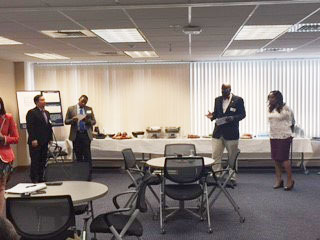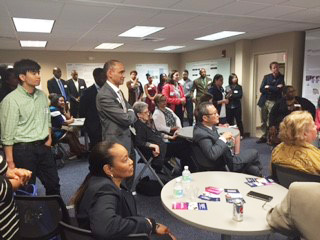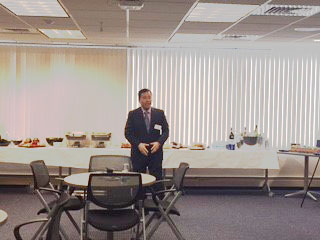The award recognizes outstanding achievement in the field of biomedical innovation through research, education, industry, translation, or clinical practice. Read full story.
Academics
UConn Engineering Boasts 9 National Academy of Inventors (NAI) Fellows
Distinguished Professor at Widener University

By Cato T. Laurencin, M.D., Ph.D.
On April 4, I was really honored to be the keynote speaker for the 2017 Distinguished Professor Lecture Series at the Widener University School of Engineering. During my talk, I shared my insights on “regenerative engineering” – the convergence of advanced materials science, stem cell science, physics, developmental biology, and clinical transition. Particularly, I focused on our current work on musculoskeletal tissue regeneration using polymeric nanofiber systems and stem cells. Thank you to Dr. Fred Akl, dean of the School of Engineering, and Dr. Rudy Treichel, associate dean, for hosting such a visit and lecture for me.
Indian National Academy of Engineering
By Cato T. Laurencin, M.D., Ph.D.
I am happy to announce I was elected a Foreign Fellow by the Indian National Academy of Engineering (INAE) for the outstanding accomplishments bridging engineering and medicine. This was the second time I was honored by India. In 2015, the Indian National Academy of Sciences also elected me as a Foreign Fellow. I am so fortunate to be the first American-born scientist elected to both academies. I am honored to be recognized by my colleagues and peers in. I am also honored to represent the University of Connecticut, demonstrating to the world the great level of science that is present at our school. I look forward to further collaborations with the talented engineers and scientists of India to advance knowledge in the service of mankind.
Annual Biomedical Research Conference for Minority Students
 By Cato T. Laurencin, M.D., Ph.D.
By Cato T. Laurencin, M.D., Ph.D.
I was honored to serve as the keynote speaker for the Annual Biomedical Research Conference for Minority Students (ABRCMS) in Tampa, FL on November 10. ABRCMS is the largest professional conference for underrepresented minority students in STEM. The theme for the meeting was “Diverse Voices, Diverse Science: A Future of Excellence in STEM Research.” My lecture, “Regenerative Engineering: The Future of Tissue Regeneration” highlighted the increasing convergence between engineering, biology, and medicine. This meeting was packed with undergraduate and post-baccalaureate students, graduate students and postdoctoral scientists and faculty, program directors and administrators. Thanks to ABRCMS for inviting me to participate in this important conference.
Convergence Report Release
By Cato T. Laurencin, M.D., Ph.D.
It was a great pleasure to appear as a member of the study panel at the Convergence Report Release Event in Washington D.C. on June 24. The report, “Convergence: The Future of Health”, draws on insights from several dozen expert participants at two workshops, as well as containing input from scientists and researchers from academia, industry, and government. Their efforts have produced a wide range of recommendations for advancing convergence research. The report outlines three major disease areas — brain disorders, infectious diseases and immunology, and cancer — and promises convergence-based approaches to tackling them. It also presents case studies of four emerging technology categories: advanced imaging in the body, nanotechnology for drug and therapy delivery, regenerative engineering, and big data and health information technology. The report was co-chaired by Tyler Jacks, the David H. Koch Professor of Biology and director of MIT’s Koch Institute for Integrative Cancer Research; Susan Hockfield, neuroscientist and president emerita of MIT; and Phillip Sharp, Institute Professor at MIT and Nobel Laureate.
The panel discussion is online, please watch the video.
Induction Ceremony for the Chinese Academy of Engineering
Speaking at UMass Amherst
By Cato T. Laurencin, M.D., Ph.D.
On April 29, I was invited to present the distinguished lecture for the annual Northeast Alliance for Graduate Education and the Professoriate (NEAGEP) and Five Colleges STEM Diversity Day. NEAGEP is one of 26 NSF-funded programs in the U.S. It focuses on increasing the number of underrepresented minority students in STEM. In my speech, ‘Innovation and Leadership in Science, Engineering and Medicine’, I shared my story and talk about aspects of the convergence of innovation and technology. I enjoyed sharing some principles for success as well as my personal philosophies in terms of successfully developing and encouraging young people in the STEM field. It was a fascinating event. Thanks to UMass Amherst for hosting the event.






